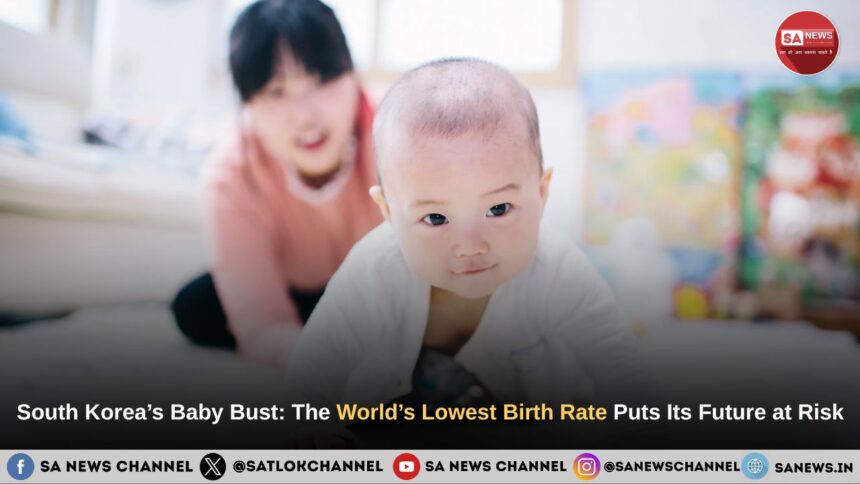South Korea is facing a historic challenge with the world’s lowest birth rate at just 0.74. Once a symbol of growth, the nation now risks demographic decline, economic slowdown, and a shrinking workforce. Experts warn that without bold reforms in gender equality, housing, childcare, and social norms, the “Miracle on the Han River” could fade. Will South Korea act in time to secure its future?
- A Nation at the Edge of a Demographic Cliff
- Why Are Women Rejecting Marriage and Motherhood?
- The Weight of Gender Norms
- The Economic Pressures of Raising a Family
- The Policy Dilemma: Can South Korea Reverse the Trend?
- Breaking Free from Tradition
- A Future in the Balance
- The Road Ahead for South Korea
- Spiritual Insight: The Divine Wisdom of Saint Rampal Ji Maharaj Ji
- FAQs on South Korea’s Fertility Crisis
South Korea’s Lowest Birth Rate Puts Its Future at Risk key points
- South Korea’s fertility rate dropped to 0.74 in 2024, the lowest among OECD (Organisation for Economic Co-operation and Development) countries.
- The replacement fertility rate needed to maintain a stable population is 2.1 births per woman. South Korea is far below this level.
- A shrinking population could trigger a permanent recession by the 2040s, warns the Bank of Korea.
- Rising education levels, changing gender norms, soaring housing costs, and career pressures are key drivers of the fertility crisis.
- Experts argue that only bold policy reforms and social acceptance of diverse family structures can prevent a demographic collapse.
A Nation at the Edge of a Demographic Cliff
South Korea, once hailed as a symbol of economic transformation and resilience, is now facing a silent crisis; its birth rate has plunged to the lowest in the world. According to official figures, the fertility rate rose slightly to 0.74 in 2024 but remains far below the OECD average of 1.5 and dramatically under the replacement level of 2.1.
The Bank of Korea has warned that unless urgent measures are taken, the country could face a prolonged economic downturn by the 2040s, undoing decades of growth that earned it the title of one of Asia’s “Four Tigers”.
Why Are Women Rejecting Marriage and Motherhood?
One of the most striking factors behind the fertility collapse is the decline in marriage rates. In South Korea, fewer than 4% of births occur outside of wedlock, making marriage almost a prerequisite for parenthood.
- In 1990, over 90% of women aged 25–49 were married.
- By 2020, this figure had dropped to 69%.
- Among university-educated women, marriage rates fell even further from 81% to 61% in the same period.
Education has played a double-edged role. With 72% of South Korean women earning university degrees by 2020 (compared to just 12% in 1990), opportunities for careers expanded. But this also reduced marriage rates, as many women now reject the traditional expectation of sacrificing professional ambitions for family life.
The Weight of Gender Norms
South Korea’s gender imbalance within households remains a major obstacle.
According to research:
- Women aged 15–64 spend 215 minutes per day on unpaid household work, compared to just 49 minutes for men.
- A survey found 65% of South Koreans believe children suffer if mothers work outside the home more than double the rate in the United States (31%).
- This cultural backdrop forces many women into an impossible choice: pursue a career and independence, or give it up for family responsibilities.
- As a result, many highly educated women are delaying or forgoing marriage altogether. “For South Korean women, having children often means sacrificing their careers, autonomy, and financial well-being,” noted a study by researcher Eunbi Song (Source: Project Syndicate).
The Economic Pressures of Raising a Family
1.Beyond social expectations, the financial burden of starting a family has become overwhelming.
2.Couples are expected to buy a home before marriage, but soaring real-estate prices in cities like Seoul make ownership nearly impossible without family support.
3.Household spending on private tutoring grew nearly 5% per year in Seoul between 2007–2022, as parents feel pressured to invest heavily in their children’s education.
With these costs, many young couples hesitate to marry, let alone have children.
The Policy Dilemma: Can South Korea Reverse the Trend?
Experts suggest that reversing the fertility decline will require bold, comprehensive policies. Recommendations include:
- Expanding affordable housing for newlyweds.
- Subsidizing early childcare and increasing parental leave.
- Creating incentives for fathers to share childcare and household labor.
- Enforcing workplace reforms to eliminate wage and promotion discrimination.
- Promoting greater social and legal acceptance of diverse family structures beyond traditional marriage.
However, reforms carry trade-offs. If men’s labor participation falls or household spending on education decreases, economic growth could slow. To balance this, South Korea would need to boost efficiency in its education system and continue investing in technology.
Breaking Free from Tradition
Analysts argue that South Korea must also confront its Confucian family traditions, which restrict social flexibility. The insistence that couples must marry before living together or having children has made family formation rigid and less appealing in modern society.
Without greater acceptance of different lifestyles, the nation’s demographic future looks increasingly bleak.
A Future in the Balance
South Korea’s fertility crisis is not merely about numbers, it represents the clash between traditional expectations and modern aspirations. Women, empowered by education and careers, are demanding equality and autonomy, while outdated norms and economic barriers hold them back.
Unless the government acts decisively to align policies with the realities of modern life, the country may soon face what the Bank of Korea has already projected: a demographic collapse leading to permanent recession by the 2040s.
The Road Ahead for South Korea
The story of South Korea has long been one of resilience and rapid transformation. From post-war poverty to technological powerhouse, it has overcome enormous challenges. But this new crisis strikes at the nation’s core and its people.
If South Korea fails to address the mismatch between women’s aspirations and social expectations, the “Miracle on the Han River” may fade into history. The next two decades will determine whether South Korea reinvents itself once again or slides into demographic decline.
Spiritual Insight: The Divine Wisdom of Saint Rampal Ji Maharaj Ji
According to Saint Rampal Ji Maharaj Ji, whether a person has children or not, one should always practice devotion, because the human body is granted specifically to perform true devotion. He explains that having children, or their number, depends entirely on past-life karma. Souls with unresolved karmic accounts may have children, while those without such obligations may remain childless. He emphasizes that souls who receive true devotion under His guidance attain liberation, ascend to Satlok, the eternal abode, and remain forever in the presence of Paramatma, free from the cycle of birth and death.
For more insights on the divine knowledge and teachings of Saint Rampal Ji Maharaj Ji, visit www.jagatgururampalji.org.
FAQs on South Korea’s Fertility Crisis
1. Why is South Korea’s fertility rate the lowest in the world?
South Korea’s fertility rate has dropped to 0.74 due to a mix of rising education levels among women, high housing costs, unequal gender roles at home, and career pressures. These factors make marriage and childbearing less attractive for younger generations.
2. What is the replacement fertility rate and how far is South Korea from it?
The replacement fertility rate is 2.1 births per woman, the level needed to maintain a stable population. South Korea’s current rate of 0.74 is less than half of this, making population decline inevitable unless trends change.
3. How does South Korea’s birth rate compare to other OECD countries?
The OECD average fertility rate is about 1.5 births per woman, while Japan stands at 1.2. South Korea is significantly lower, holding the world’s lowest rate at 0.74.
4. What economic risks does South Korea face due to low fertility?
According to the Bank of Korea, the nation could face a permanent recession by the 2040s as the workforce shrinks, tax revenues decline, and public spending on elderly care increases.
5. What solutions are being proposed to fix South Korea’s fertility crisis?
Experts recommend expanding affordable housing, subsidizing childcare, enforcing workplace equality, encouraging fathers to share child-rearing, and loosening traditional norms that restrict family structures to marriage only.









